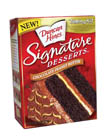
This should not present much concern for manufacturers, as freshness can be duplicated by mixes baked at home. The convenience of the in-store bakery, however, is a more formidable foe. Simply put, the convenience in purchasing a ready-to-eat dessert cannot be duplicated easily by any baking mix.
In-store bakeries also have seen an increase in space and development costs, allowing for the creation of higher-quality products. Even mass merchandisers have begun to offer premium products, while gourmet-type grocers have begun to sell baked goods in small portions, along the lines of single-serve pie and cake slices.
Bakery mixes, in fact, have relatively few grounds on which to compete, but one is significant in the eyes of the consumer: price. A premium in-store cake or pie can retail for $10 or more; baking mixes, on the other hand, rarely go higher than $4.99.

The Mix Mix
The cake/cupcake/pie mix portion comprises the largest element of the category, accounting for one quarter of the overall market. Minimal sales growth—sales declines, in fact, when accounting for inflation—managed to offset gains by smaller segments during the period under review (1999-2004). A variety of factors have contributed to this segment's poor fortunes, including low-carb diets and in-store bakeries. The latter, in particular, has capitalized on its convenient aspect, as well as its ability to deliver a wide variety of flavors and creations, such as cream-filled or multi-flavored.Premium mixes, along the lines of General Mills' Betty Crocker Supermoist cakes, had been a stalwart of the segment, but their sales dropped to $110 million in 2004, from $118 million in 2001. In its report on the U.S. market for baking and gelatin/pudding mixes, Mintel attributes this decline to competition from other outlets and segments, while noting that new product innovation might help revitalize this segment.
Low-carb dieting prompted a decline in the gelatin/pudding mix segment, which did see a rebound with a series of sugar-free and low-/no-fat pudding products. Nevertheless, inflation-adjusted sales in 2004 were markedly off from their 1999 levels. Sales peaked in 2003, the height of the low-carb trend, and again surged in 2004, though more slowly as interest in low-carb dieting began to wane and other low-carb baking mixes hit the market. Mintel believes the popularity of gelatins and puddings with children will bode well for the segment, as will the fact that sugar-free varieties are “ideal for any type of diet, including the glycemic index.”
While other segments saw sales on a downward slide during the period under review, brownie mixes have fared fairly well. Sales did drop slightly in 2001, but they have been on an upward swing since, even when accounting for inflation. Gourmet brownie mixes compete well with in-store bakery items. In-store bakeries may sell gourmet brownies by the slice, but the price can be prohibitive, especially considering the consumer can purchase a box mix (which will provide an entire pan of upscale brownies) for nearly the same cost. At the same time, these brownie types can be termed a “grown-up” treat for adults looking for a sweet indulgence. For instance, Duncan Hines Chocolate Lovers Brownie Mix saw sales triple between 2001 and 2004—rising from $4.8 million to $15.6 million.
The effects of in-store competition and low-carb dieting have hit muffin mixes hard, with sales declines every year since 2000. Mintel does not regard low-carb dieting as the biggest concern for muffin mixes (likely because of the decline in consumer interest in the diets), but in-store bakeries can provide high-quality muffins typically for less than a couple of dollars. Furthermore, not only can these muffins be found in groceries; they also are available in coffee shops and convenience stores, tailor-made for on-the-go consumption. As a result, long-term icons in the segment have seen their fortunes suffer; flagship brands from Duncan Hines and Betty Crocker have declined 42% and 17.5%, respectively, between 2000 and 2004. Carb-cutters impacted the segment, as well: in 2001, Atkins debuted its muffin mixes, which grew to $9.5 million in sales by 2004.
Conversely to most of the other segments, pancake/waffle mixes bore little after-effects from direct competition with in-store bakeries. The impact of low-carb diets, however, was more pronounced and not entirely because of the mixes themselves. Pancakes and waffles typically are accompanied by butter, syrup, fruit sauces high in sugar, even whipped cream. Plus, other low-carb breakfast offerings, including low-carb muffin mixes, lured consumers.
Frozen Stiff Competition
Further complicating matters for pancake/waffle mixes is the convenience found in the frozen aisle. Frozen waffles and pancakes also met some consumer desires with low-carb products under such name brands as Eggo. The decline of low-carb dieting may stabilize the segment, but Mintel believes manufacturers must “find ways to package these products with low-sugar offerings and low-sugar accompaniments, especially as competition from frozen microwave/toaster waffles and pancakes increases.”Much like the other segments, cookies and cookie bars also have suffered at the hands of low-carb diets and in-store bakeries, as well as gourmet mixes like those found in the brownie mix category. Refrigerated dough is yet another competitor to cookie mixes, combining the consumer desire to “cook” and virtually no preparation. Recent refrigerated cookie dough is even pre-cut and, while it may not offer the extended shelflife of a baking mix, it “does offer spontaneity and a premium-quality product that can be baked at home, either in cookie or cookie bar form, with a higher level of convenience than a mix,” to quote Mintel. Newer, gourmet products could turn that tide, possibly by incorporating premium ingredients such as white chocolate, toasted nuts or coconut flakes, or upscale confectionery bits. The segment has faced quite an abrupt change in fortunes over the course of the period under review. Between 1999 and 2001, the segment tallied double-digit sales growth, even high single-digit growth in inflation-adjusted terms. However, since 2002, current and inflation-adjusted sales have declined 2%-3% and 4%-5.5%, respectively.
The greatest damage from low-carb diets and in-store bakeries, however, has been in the coffeecake/gingerbread/pastry mix segment. In-store bakeries have impacted coffeecake mixes, in particular, because these can be purchased pre-made on the way to work or social occasions. Furthermore, the in-store bakery can offer a wide variety of coffeecakes, featuring fresh exotic fruits like kiwis and mangos, as well as caramel, gourmet nuts, meringues and whipped cream, not generally available in mixes. General Mills saw a 50% decline in sales of its mixes in this segment and, like other companies, appears to be putting its efforts into other areas, such as cakes and brownies.
Mintel groups rice baking mixes and tortilla mixes into the “other mixes” segment, and this area saw sagging fortunes for the bulk of the period under review but did show signs of improvement in the final year (2004), registering increased sales in current and inflation-adjusted terms. The growth has been primarily in tortilla mixes, appealing to Hispanic consumers and other American groups interested in Hispanic foods. The Hispanic population continues to increase in the U.S., and Hispanics traditionally have been strong consumers of gelatin and pudding products, Mintel notes. Many traditional desserts are based on those ingredients, including using gelatin made with milk rather than water. This year, General Mills' Pillsbury Bake-off is including an award for best Hispanic-based entry, an example of the company's interest in developing Hispanic products and recipes.

Consuming
Of all households surveyed in Mintel's exclusive consumer research, 64% say they use cake mix and pudding, followed by 54% that use brownie mix. Households with children are more apt to purchase baking and dessert mixes regularly, with the most popular being from the Betty Crocker and Duncan Hines stables. A variety of reasons are behind this increased usage in households with children, not the least of which are the need for the convenience of quick and easy-to-prepare baking mix, and cost. Even the most premium products will cost less than pre-made items of the same quality and type.Women are the primary users of dessert mixes, though there was a strong showing of single fathers who keep mixes on hand. For households with children learning to bake, these mixes also are proving popular, as they tend to require only a few ingredients and one bowl for preparation. The same is the case for even younger children and pudding mixes, with the need for heating or baking eliminated. A slight decrease in the population of 5- to 13-year-olds may portend trouble for the category, but the Census Bureau has projected an increase in the under-five age group, presenting the possibility of an increase in this consumer base in the near future. If the size of the under-five group continues to grow, the market will have a greater opportunity to regain sales as those children come of age to want desserts made from mixes. However, public concerns about obesity and the relationship of obesity to sugar in foods could impact the category as well. Actively looking for limited-sugar treats for their children, parents could well turn to low-sugar baking mixes.
The interest in convenience could be a double-edged sword for the industry, however. The products are simple to prepare, many requiring few additional ingredients other than water. Mintel's research found 64% of respondents keep such mixes on hand for emergencies, such as unexpected company or social events.
On the other hand, the in-store bakery offers the ultimate in convenience, as well as high quality. Mintel reasons, “It is difficult to compete with a product that is fully prepared, but given that nearly two-thirds of respondents keep mixes on hand for emergencies, they remain the more convenient option when faced with making a special trip to the bakery.”
Can in-store bakeries serve as a viable option for consumers seeking organic options? As Mintel notes, the organic industry is growing significantly, with sales nearly doubling to $5.3 billion in 2004, according to the group's report “Organic Food and Beverages—U.S., August 2004.” While the study did not segment baking mixes, it did note a 48% increase in sales of organic snacks and desserts between 2001 and 2004. Furthermore, consumers have demonstrated a willingness to pay a premium for organic options, as they believe these items are safer and of higher quality than non-organic products.
The category has potential in niches other than organic, however. Possibilities are emerging for mixes to address food allergies, in the form of gluten- and peanut-free products, as well as kosher and ethnic items. Trendy diets, however, will continue to pose sizable challenges, considering most diet plans discourage the consumption of high-calorie baked goods. Still, consumers have demonstrated that they will return to baked treats and, as such, manufacturers should “continue developing new products for the time when the current diet trend reverses,” advises Mintel.
In 2004, sales increased slightly to surpass the $2 billion mark—the size of the market in 1999. When adjusting for inflation, the period actually saw a 13% decline, and Mintel believes this lack of growth will persist through 2009. Cake, cupcake and pie mixes may comprise the largest segment, but it will grow only about 1% annually, a 9% slide in inflation-adjusted terms. The steepest decline will be seen in pancake and waffle mixes, dropping an inflation-adjusted 29% through 2009, due largely to competition with ready-to-eat varieties such as toaster-ready and microwave. An 18% inflation-adjusted drop will befall muffin mixes, resulting from the proliferation of coffee shops offering breakfast pastries. Much slighter declines (but declines, nonetheless) will be seen in sales of brownie mixes, which will decrease at an inflation-adjusted annual rate of 0.6% through 2009.
This article contains information from the Mintel report “Baking and Dessert Mixes-U.S.-June 2005.” Please visit http://reports.mintel.com for more information or call Mintel at 312-932-0400.
